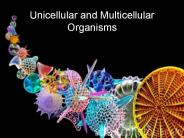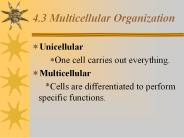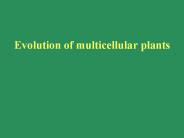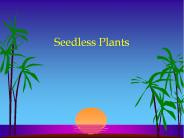Multicellular PowerPoint PPT Presentations
All Time
Recommended
Multicellular Organisms Cell Teamwork: The Processes of Life Objectives At the end of this PowerPoint, you will be able to: Explain the common problems that ...
| PowerPoint PPT presentation | free to view
Multicellular Primary Producers ~ Seaweeds Seaweeds marine Macroalgae Threee types red, brown, and green algae Most species are benthic Can be fouling ...
| PowerPoint PPT presentation | free to view
Unicellular and Multicellular Organisms Unicellular Organisms Unicellular organism are one celled living things. Algae are one celled organisms that contain ...
| PowerPoint PPT presentation | free to download
Multicellular Organization I. Tissues, Organs, & Organ Systems a) Cells are organized into tissues (a group of cells that carry out a specific function) b) Types of ...
| PowerPoint PPT presentation | free to view
Title: ENVI 21 Life in the Ocean Author: Ron Kaufmann Last modified by: USD Created Date: 9/2/2003 2:36:55 AM Document presentation format: On-screen Show
| PowerPoint PPT presentation | free to download
Flowering Plants (Angiosperms) Flowering plants have true leaves, stems and roots (unlike multicellular algae) ... Flowers typically small and inconspicuous (Why? ...
| PowerPoint PPT presentation | free to download
4.3 Multicellular Organization Unicellular *One cell carries out everything. Multicellular *Cells are differentiated to perform specific functions.
| PowerPoint PPT presentation | free to download
microscopic to seaweeds hundreds of feet in length. Do not have true ... Stemlike structures are called the stipe. Store food as a carbohydrate called laminarin ...
| PowerPoint PPT presentation | free to view
Title: No Slide Title Author: Enter your full name here, and your initials below. Last modified by: OlsenEr Created Date: 7/31/2003 2:32:30 PM Document presentation ...
| PowerPoint PPT presentation | free to view
By means of cell adhesion molecules, CAMs, cells are capable of recognizing each ... A family of Ca2 -dependent CAMs. Ca2 causes dimerization of Cadherins ...
| PowerPoint PPT presentation | free to view
Title: PowerPoint Presentation Author: McDougal Littell Last modified by: HMCo Created Date: 9/14/2006 4:17:10 PM Document presentation format: On-screen Show
| PowerPoint PPT presentation | free to download
By means of cell adhesion molecules, CAMs, cells are capable of ... CELL ADHESION MOLECULES ... in integrin 2 lead to leucocyte-adhesion deficiency. ...
| PowerPoint PPT presentation | free to view
Structure of their secretory units. The four types of tissues ... Found throughout the body; most abundant and widely distributed in ... of vascularity ...
| PowerPoint PPT presentation | free to view
Challenges. Going from unicellular to multicellular 'Communication' between cells ... Photos of slime moulds. http://www.hiddenforest.co.nz/slime/intro.htm ...
| PowerPoint PPT presentation | free to download
Multicellular Algae: The Seaweeds and Marine Plants I. Multicellular Algae Marine Algae = seaweed = macrophytes Classified in either Plantae or Protista depending on ...
| PowerPoint PPT presentation | free to download
Organ Systems a group of organs that work together to perform a ... Colonial Organisms collection of genetically identical cells that live together. Volvox ...
| PowerPoint PPT presentation | free to view
The earliest organisms were prokaryotes without nuclei (ex. bacteria) which relied on the ... Volvox. The story of multicellular organisms continued...
| PowerPoint PPT presentation | free to view
Origins of Multicellular Animals Three Hypotheses Syncytial ciliate hypothesis Ancestor is single celled ciliate with multiple nuclei Colonial flagellate hypothesis ...
| PowerPoint PPT presentation | free to view
Scientific American 'Bacteria as Multicellular Organisms' ... Sporulation and Formation of Dormant Cells. Exchange of Genetic Information. Mutation ...
| PowerPoint PPT presentation | free to view
... fish is also protandry Finding Nemo is wrong! Dad should become Mom! Clown anemonefish & eggs with sea anemone The Other Anthozoan ...
| PowerPoint PPT presentation | free to download
... 100:1484-1489 Properties Self-renewal Potency Totipotent Pluripotent Multipotent Oligopotent Unipotent Spatial gradients of ... morphogenetic processes, as well ...
| PowerPoint PPT presentation | free to view
Multicellular and Tissue Level Organization Chapter 9 Multicellularity Multicellularity Multicellular organisms have existed for 550 million years 10 % of geological ...
| PowerPoint PPT presentation | free to view
PLANTS FYI: Characteristics of Plants Multicellular Eukaryotic Photosynthetic 6CO2 + 6H20 + Light energy C6H12O6 (glucose) + 6O2 Have cell walls made of cellulose ...
| PowerPoint PPT presentation | free to view
Evolution of Multicellular Life Section 17 3 This section describes how multicellular life evolved from its earliest forms to its present-day diversity.
| PowerPoint PPT presentation | free to download
Organ Level: Several different types of tissue that function together for a ... D. The FOUR Plant Organs are ROOTS, STEMS, LEAVES AND FLOWERS. COLONIAL ORGANIZATIONS ...
| PowerPoint PPT presentation | free to view
Chapter 9 Eukaryotic Cells and Multicellular Organisms Figure CO: Oblong shaped Giardia Courtesy of Dr. Stan Erlandsen/CDC Eukaryote Origins Remain Unclear Which came ...
| PowerPoint PPT presentation | free to view
Mitosis, Significance to unicellular and multicellular organisms, Chromosomes Significance of cell reproduction to multicellular & unicellular organisms 2.
| PowerPoint PPT presentation | free to view
Unicellular organisms may form groups, chains, films, colonies, etc. but this ... Volvox is an example of a unicellular colonial eukaryotic microorganism (algae) ...
| PowerPoint PPT presentation | free to view
... Plant Evolution (Common with Algae) Multicellular and Eukaryotic Cell walls made of Cellulose ... Homologous Chloroplasts Sperm ultrastructure ...
| PowerPoint PPT presentation | free to download
Can also move, proliferate, shed and die. Replenishment ... The fewer neighbors a cell has, the higher the chance of being shed ...
| PowerPoint PPT presentation | free to view
Functional: show similarity to proteins with known function encode putative protein sequences ... used to group the transcripts by their putative function. ...
| PowerPoint PPT presentation | free to view
Coordinate their behavior within the organism. Adjust their metabolism ... Osmosis = the diffusion of water across a membrane (cell membrane) ...
| PowerPoint PPT presentation | free to view
Title: PowerPoint Presentation Author: Unknown User Last modified by: brankin Created Date: 2/19/2005 12:00:18 AM Document presentation format: On-screen Show (4:3)
| PowerPoint PPT presentation | free to view
Multicellular organisms first appeared during the Paleozoic era. ... Dinosaurs, birds, flowering plants, and first mammals appeared. ...
| PowerPoint PPT presentation | free to view
Fungus Characteristics -eukaryotic cells - multicellular / unicellular (yeast) - heterotrophs : many are decomposers Structures - hyphae : basic unit of multicellular ...
| PowerPoint PPT presentation | free to view
Introduction to Cells Unit 4 Unicellular or multicellular Leaf Cells Eukaryotic or prokaryotic? Unicellular or multicellular Protists Eukaryotic or prokaryotic?
| PowerPoint PPT presentation | free to view
Introduction to Biology Unit 4 7. Unicellular or Multicellular Leaf Cells Eukaryotic or Prokaryotic? 8. Unicellular or Multicellular Protists Eukaryotic or ...
| PowerPoint PPT presentation | free to view
Ch. 22 Plant Diversity 22-1: Introduction to Plants Kingdom Plantae: Multicellular eukaryotes Cell walls Cellulose Develop from multicellular embryos ...
| PowerPoint PPT presentation | free to view
Chapter 3 Lesson 2 How do unicellular and multicellular organisms differ? How does cell differentiation lead to the organization within a multicellular organism?
| PowerPoint PPT presentation | free to download
Title: 31.1 Animals are multicellular heterotrophs without cell walls. Some General Features of Animals Animals are multicellular heterotrophs that are diverse in ...
| PowerPoint PPT presentation | free to view
Introduction to Cells Unit 4 Unicellular or multicellular Onion Root Cells Eukaryotic or prokaryotic Unicellular or multicellular? Athlete s Foot Fungus Eukaryotic ...
| PowerPoint PPT presentation | free to view
What Characteristic Define an Animal? Eukaryotic cells Multicellular Ingestive Heterotroph
| PowerPoint PPT presentation | free to download
PLANTS! Overview of Plants Are plants multicellular or unicellular? Multicellular Eukaryotic or Prokaryotic? Eukaryotic Of what is their cell wall composed?
| PowerPoint PPT presentation | free to view
Animal Diversity 2 Multicellular, eukaryotic, heterotrophic organisms that feed by INGESTION
| PowerPoint PPT presentation | free to view
Review the Animal Kingdom 4 Major Characteristics? Multicellular Eukaryotic Heterotrophs Cells lack cell walls
| PowerPoint PPT presentation | free to download
The Kingdom Fungi Chapter 21 Structure and Function of Fungi Structure and Function Multicellular (except yeasts) Composed of hyphae thin filaments one cell thick ...
| PowerPoint PPT presentation | free to download
Biodiversity How has the diversity of multicellular life changed over time? Multicellular life started from only one kind and is now many kinds, so, duh.
| PowerPoint PPT presentation | free to download
General Histology Epithelium Blood Fertilization: formation of zygote Cleavage: becoming multicellular Gastrulation: fomation of 3 primary tissues ectoderm ...
| PowerPoint PPT presentation | free to view
... Porifera Overview Most primitive of the multicellular animals There is some debate if sponges are complex colonial protozoans ... Evolution Characteristics ...
| PowerPoint PPT presentation | free to view
Classification Biology I Kingdom Animalia All eukaryotic, multicellular, heterotrophic, motile (most) organisms Common Phyla: Porifera (sponges, corral) Cnidaria ...
| PowerPoint PPT presentation | free to view
Parasitic Worms. Pathogenic Human Helminthes and Arthropods. Characteristics. Multicellular ... Arthropod Parasites. Pediculosis. Human Lice. Head. Body ...
| PowerPoint PPT presentation | free to view
... Animal-like, microscopic, unicellular (protozoans) Plant-like, microscopic, unicellular (microalgae, phytoplankton) Plant-like, macro, mostly multicellular ...
| PowerPoint PPT presentation | free to view
The Kingdom ANIMALS Eukaryotic cells Multicellular Heterotrophic by ingestion External Fertilization vs Internal Fertilization a. Invertebrate Chordates: Tunicates ...
| PowerPoint PPT presentation | free to view
BOTANY The Study of the plant kingdom Examples Characteristics of Plant Kingdom Are multicellular eukaryotes that are photosynthetic autotrophs Contain chloroplasts ...
| PowerPoint PPT presentation | free to download
Rotifers Rotifera Unknown relationship to other phyla Pseudocoelomate Protonephridia Ciliated lobes whirl water into mouth Parthenogenesis Smallest multicellular ...
| PowerPoint PPT presentation | free to view
6 Kingdoms of Life * * * * * * * * * * * * * * * * * * * * * * * * * * * * * Flowering plants Angiosperms Animalia All animals are multicellular and made of the more ...
| PowerPoint PPT presentation | free to download
























































